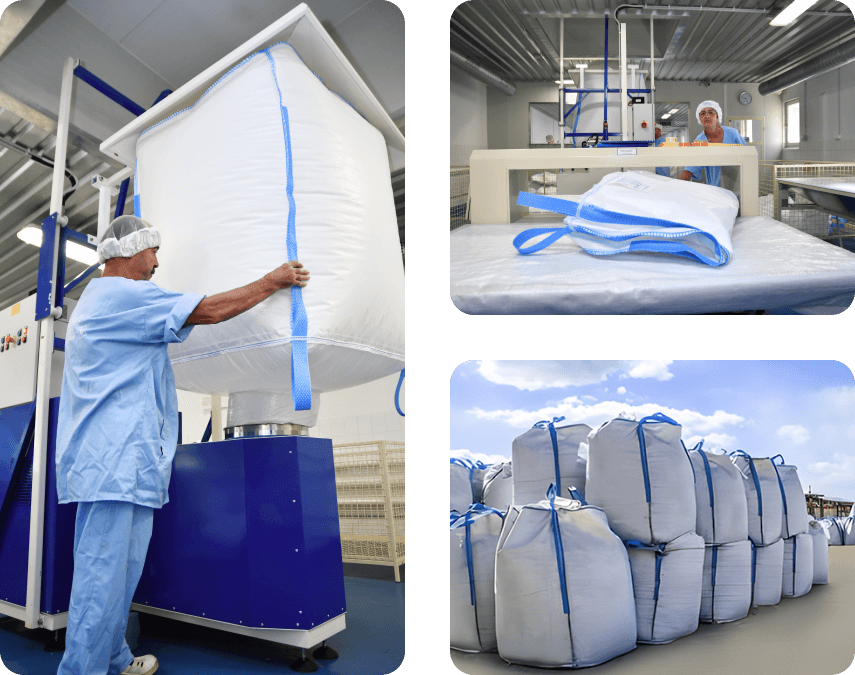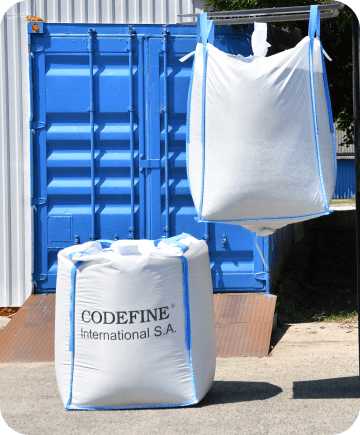Home » Posts Page » Blog » Products and Materials » FIBCs vs. Traditional Packaging Materials: When to Use Each

Initial purchase costs present a deceptive comparison point between FIBCs and traditional packaging. While the per-unit cost of an FIBC may appear higher than individual paper bags, cardboard boxes, or even some drums, the true cost comparison must account for capacity differences. A single FIBC can replace numerous smaller containers, creating economies of scale that dramatically reduce the per-kilogram packaging cost. For operations handling substantial material volumes, this cost advantage becomes increasingly significant as quantities rise.
Transportation economics strongly favor FIBCs for bulk materials due to their superior space utilization and weight efficiency. The flexible construction allows FIBCs to conform to available space in trucks, containers, and rail cars, maximizing load density. Traditional rigid packaging leaves significant void spaces that effectively ship air instead of product, increasing freight costs per unit of material. The lower packaging-to-product weight ratio of FIBCs also reduces transportation costs, particularly for long-distance shipments where weight directly impacts fuel consumption and associated expenses.
Labor costs for handling and processing represent another area where FIBCs create substantial savings. A single operator with appropriate equipment can handle an FIBC containing up to 2,000 kg of material, while moving an equivalent amount in traditional packaging might require multiple workers and significantly more time. This efficiency extends to both loading and unloading operations, creating labor savings throughout the logistics chain. For operations with high labor costs or tight staffing constraints, this advantage alone can justify the switch to FIBCs.
Total cost of ownership calculations reveal the true economic advantage of FIBCs when all factors are considered across the product lifecycle. Beyond direct purchase and freight costs, FIBCs reduce expenses related to handling, storage, disposal, and even product loss through better protection. These accumulated savings grow with scale, making FIBCs particularly advantageous for high-volume operations where incremental efficiencies create substantial bottom-line impact. Many operations report cost reductions of 30-50% after switching from traditional packaging to FIBCs for appropriate applications.
Real-world examples demonstrate these savings across multiple industries. A chemical manufacturer switching from 25 kg paper bags to FIBCs for raw material handling reduced packaging costs by 40% while simultaneously cutting labor requirements in half. An agricultural operation moving from drums to FIBCs for fertilizer distribution achieved similar savings while also reducing product contamination and improving worker safety. Such examples highlight how the cost advantages of FIBCs compound throughout the supply chain, creating financial benefits that extend far beyond simple material savings.
Load capacity represents one of the most dramatic performance differences between FIBCs and traditional packaging. A standard FIBC safely handles 500-2,000 kg of material, dwarfing the capacity of paper bags (typically 20-50 kg) or even plastic drums (generally under 220 kg). This exceptional weight-bearing capability stems from specialized construction techniques including reinforced lift loops, enhanced seam designs, and strategic fabric weight distribution. For operations handling substantial material volumes, this capacity difference translates directly to operational efficiency through reduced handling requirements.
Moisture and contamination protection capabilities depend on specific design features rather than packaging type alone. Standard FIBCs provide good protection against dust and general contamination, while specialized versions incorporate moisture barriers or liner systems that match or exceed the protection of traditional packaging. PE-lined FIBCs offer excellent moisture resistance for hygroscopic materials, while food-grade and pharmaceutical variants include features that ensure product purity throughout the supply chain. The key distinction lies in customization options: FIBCs can be precisely engineered for specific protection requirements without excessive overdesign.
Storage stability characteristics differ fundamentally between packaging types. FIBCs designed for stacking (particularly baffle designs and Q-bags with square bottoms) maximize warehouse space utilization through stable vertical stacking. Traditional rigid containers might offer simpler stacking for smaller quantities but cannot match the space efficiency of well-designed FIBCs at scale. The flexible yet stable nature of FIBCs allows them to conform slightly to uneven surfaces while maintaining overall load integrity, creating stable storage configurations even in less-than-ideal warehouse conditions.
Transportation safety features vary by packaging type, with each offering distinct advantages. FIBCs excel at secure containment of large material volumes, with specialized designs like baffled bags preventing load shifting during transport. Traditional packaging might offer advantages for certain hazardous materials requiring rigid containment, though specialized FIBCs (Types C and D) with anti-static properties safely transport many materials that would be dangerous in conventional packaging. The key distinction lies in scale-appropriate safety: FIBCs provide bulk material security that would require dozens or hundreds of traditional containers to match..
High-volume bulk material handling scenarios represent the clearest case for FIBC adoption. When you’re regularly moving materials in quantities exceeding 500 kg, the efficiency gains from consolidating multiple smaller packages into a single FIBC become undeniable. Industries processing substantial raw material volumes or shipping finished products in bulk quantities find that FIBCs dramatically streamline operations by reducing handling requirements, simplifying inventory management, and accelerating loading/unloading processes. The advantage grows progressively stronger as volumes increase, making FIBCs particularly compelling for large-scale operations.
Rapid loading and unloading requirements strongly favor FIBCs for appropriate materials. Their specialized filling and discharge designs, combined with high individual unit capacity, create throughput capabilities that traditional packaging simply cannot match at scale. Fill rates exceeding 20 tons per hour and discharge rates approaching 10 tons per hour become possible with properly designed systems, dramatically outperforming what could be achieved with smaller packaging units. For operations where time efficiency drives profitability, this speed advantage alone can justify the switch to FIBCs.
Small quantity requirements often make traditional packaging more practical and economical. When you’re handling materials in amounts less than 200-300 kg, the capacity advantage of FIBCs becomes less relevant, while the handling convenience of smaller traditional packages becomes more valuable. Operations shipping limited quantities to multiple destinations generally find that appropriately sized bags, boxes, or drums offer better overall efficiency than partially-filled FIBCs. Similarly, products with limited production runs or specialized formulations that don’t justify bulk handling benefit from the flexibility traditional packaging provides for smaller quantities.
Enhanced contamination protection requirements might necessitate traditional packaging in certain specialized applications. Products requiring hermetic seals, sterile barriers, or specialized atmosphere control sometimes benefit from the rigid structure and sealing capabilities of conventional containers. While advanced FIBC designs with liners and specialized closures offer excellent protection for many applications, certain highly sensitive materials or regulatory-driven requirements might still favor traditional alternatives, particularly for pharmaceuticals or specialized food ingredients with exceptional purity requirements.
Chemical industry applications require careful evaluation of safety factors, material compatibility, and regulatory compliance when choosing between FIBCs and traditional packaging. Type C and Type D FIBCs with anti-static properties provide safe handling options for flammable powders and granules that might create dangerous static discharge risks in conventional packaging. Chemical manufacturers appreciate specialized FIBC constructions with high chemical resistance for aggressive materials, while also valuing the reduced exposure risk during handling compared to managing multiple smaller containers. For hazardous materials subject to transportation regulations, properly certified FIBCs offer compliant bulk shipping options that streamline regulatory documentation while maintaining safety standards.
Food and agricultural applications benefit from FIBCs with food-grade certifications and specialized contamination prevention features. These industries particularly value the clean discharge characteristics of well-designed FIBCs that minimize product loss and contamination risk during transfers. UV-stabilized constructions prove valuable for agricultural products stored outdoors, while moisture-resistant designs protect hygroscopic food ingredients throughout the supply chain. Traditional packaging remains preferable for retail-ready products or ingredients requiring precise portioning, but bulk ingredients increasingly move in specialized FIBCs that maintain purity while reducing handling costs.
Pharmaceutical sector requirements often necessitate specialized packaging with exceptional contamination control and comprehensive traceability. Clean room manufactured FIBCs with pharmaceutical-grade liners provide viable bulk options for ingredients and excipients while maintaining required purity standards. Traditional packaging still dominates for finished pharmaceuticals and specialized ingredients, particularly where regulatory approval pathways are well-established for conventional options. The decision between packaging types typically depends on material volumes, handling requirements, and specific regulatory considerations for each substance involved.
Mining and mineral processing operations leverage heavy-duty FIBCs with extraordinary strength characteristics for materials that would overwhelm most traditional packaging. Specialized constructions with reinforced lift loops and enhanced body fabric withstand the extreme weights and abrasive properties of mineral concentrates and processed materials. The dust containment capabilities of properly sealed FIBCs address environmental and safety concerns while simplifying material transport from remote locations. Traditional packaging rarely competes effectively in these applications except for specialized testing samples or retail-packaged consumer products derived from the primary materials.
Codefine International SA brings unparalleled expertise to industrial packaging decisions through comprehensive consultation services that optimize your entire packaging process.
Their packaging portfolio spans both FIBC solutions and traditional packaging materials, allowing truly objective recommendations based on your operational needs rather than limited product availability. This comprehensive approach ensures you receive guidance focused on your best interests rather than forcing a particular packaging type that might not be optimal for your specific application. The Codefine team excels at identifying which materials and processes within your operation would benefit from FIBC implementation while recognizing applications where traditional packaging remains the better choice.
Codefine’s manufacturing capabilities encompass the complete range of FIBC specifications, from standard designs to highly specialized constructions engineered for specific applications. Their expertise spans all FIBC types (A, B, C, and D) with their varying static protection properties, along with all major construction variants, including baffle bags, U-panel designs, and Q bags with square bottoms. This manufacturing depth ensures you receive exactly the right FIBC design for your specific requirements rather than compromising with a standardized product that doesn’t fully address your operational needs.
Container liner solutions represent another Codefine specialty, with options ranging from basic moisture protection to specialized designs for highly sensitive materials. These liners transform standard FIBCs or traditional containers into packaging suitable for materials with exceptional purity requirements or challenging flow characteristics. The ability to customize liner specifications to your exact material properties ensures optimal product protection and discharge efficiency throughout the supply chain.
Polypropylene product offerings extend beyond FIBCs to include specialized woven and non-woven materials that address specific packaging requirements across multiple industries.
Why not explore our complete product range online today? Do you have a question? Get in touch to speak to the team or to arrange a quote today.
